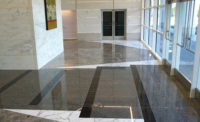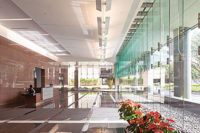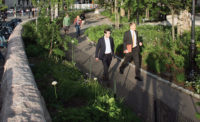In 1889, almost two decades after Gilmer purchased “The Rock,” the old Cape Fear and Yadkin Valley Railroad was built from Greensboro to Mount Airy, NC. A firm of builders, Thomas Woodruff and Sons, who were commissioned to construct several railroad stations along the way, quickly learned about “The Rock” and purchased it from Gilmer for only $5,000. Hence, the quarry is historically known as “changing hands for nothing.” The Woodruff family then bought additional land surrounding “The Rock” to build cutting plants and facilities; quarrying began in 1889 and has continued since without interruption.
The quarry operated under the name of Thomas Woodruff & Sons until 1904, when the NCGC was organized. At that time, operations consisted of quarrying and shipping rough granite blocks to jobsites to be fabricated onsite. In order to form an official corporation and expand operations, the company drew in investors from Canada to Florida — and even Pennsylvania, where the principal office was located for a short period of time. In 1910, the investors persuaded the Woodruffs to employ a superintendent of the quarry, John D. Sargent, given his in-depth experience in quarrying and finishing. In 1920, Sargent leased a shed from the Woodruffs and began his own finishing business, J.D. Sargent Granite Company, which became such a success that it created friction between both businesses. As a result, Sargent purchased the quarry from the Woodruffs and eventually merged the two businesses to create a single entity — the NCGC.
Today, NCGC has two active quarry locations — one in Mount Airy, NC, and the other in Greene County, GA — each of which extracts an exclusive type of granite. The Mount Airy quarry produces White Mount Airy granite®, which is white with tiny black specks throughout; and the Greene County quarry produces Greene County granite®, which has a buff black and white background, medium to coarse grain, with light tones of beige throughout. Altogether, the company offers 25 colors of granite, eight different colors of marble, three different colors of sandstone and two different colors of limestone.
NCGC’s main operation, including fabrication plants and the White Mount Airy granite® quarry, employs 122 workers, according to company president and CEO, William Swift. “This year, we’re celebrating 125 years of continuous operation,” he said.
Currently spanning a total of 60 acres, the White Mount Airy granite® quarry operates year-round and produces 50,000 cubic feet of stone each month, which can be increased easily according to work demands. Swift said the company has no reason to expand the quarry, given its size and depth. Geological mapping shows the total mass of the quarry to be more than 7 miles and between 6,000 and 7,000 feet deep. To translate that into laymen’s terms, NCGC has only scratched the surface in terms of quarrying, and geologists have said it can continue to quarry for another 500 years without exhausting its natural supply.
Extracting and processing the stone
Mount Airy granite’s deposit is a homogenous mass free from natural bed planes and cracks. To extract the various blocks of granite from the Mount Airy quarry, NCGC uses diamond wire saws, drilling, water-jetting and rifting, according to Swift. “Typically, we quarry for [blocks that are] 10 feet, 6 inches x 5 feet, 6 inches x 4 feet,” he said. “The Mount Airy quarry allows us to quarry blocks to meet the requirements of the project.”
To cut and process the stone, diamond wire saws, CNC diamond saws and automated finishing machines are used; sometimes, stones are also hand-cut. Recently, the company invested in some new machinery, including the F40 Falcon multi-strand diamond wire saw (used for thin slabs) and the Grani Roc quarry wire saw.
The various types of stone produced by NCGC have a wide range of uses, including cladding, building panels, veneers, curb construction/repair, paving, flooring, coping, sills, treads, risers, memorials, mausoleums/columbariums, statues/monuments, parks, plazas, churches, walls, outdoor signs and much more. Some notable projects that have utilized NCGC’s signature granites include the National World War II Memorial in Washington, DC; the Brooklyn Battery Tunnel Ventilation Building on Governors Island in Brooklyn, NY; the United Arab Emirates Chancery in Washington, DC; the Aon Center (Amoco Building) in Chicago, IL, the world’s largest granite-clad building; and its most recent award-winning project, the FDR Memorial located in New York City’s FDR Four Freedoms Park on Roosevelt Island. The FDR Memorial received the 2013 Grand Pinnacle Award from the Marble Institute of America (MIA) and also received a Tucker Award from the Building Stone Institute (BSI) this past May.
Supporting the “green” movement
NCGC continues to dedicate part of its mission towards “going green” and participating in environmentally friendly practices. “We have a crusher operation that helps us use 99.9% of our waste,” said Swift. “The material is used for precast panels and also crushed product for highways.” A section on the company’s website, “Crushed Stone,” details all of the different types of stone that are recycled and re-used, and all that goes into the process.
“NCGC is also in the process of applying for certification by ANSI/NSC 373 Sustainable Production of Natural Dimension Stone,” added Swift. The American National Standards Institute (ANSI) developed this standard to document and improve the sustainability profile of natural dimension stone production.
A detailed blog on NCGC’s website, www.ncgranite.com, written by employee Jeffery Matthews, also details the many ecological efforts of the company. “North Carolina Granite does not use any chemicals in its production processes,” he said. “In production, waste is controlled and water is recycled in the plant. Waste streams, or even those taken from stone paneled jobsites, can be recycled, crushed and used for road bedding thus contributing to waste management. Every pound of granite taken from the Mount Airy quarry is processed into a sellable product including dust fines — 100% yield. We believe we are the only stone company to accomplish that.”
Its domestic products also qualify for LEED certification. “In order for a dimensional stone producer to qualify for credits under LEED, at least 20% of its fabrication must be performed locally and 50% of the 20% must be from stone quarried locally as a percentage of the delivered total cost of material,” explained Matthews. “The ‘local’ aspect implies it must be within a 500-mile radius from the factory to the jobsite. Canadian companies usually cannot qualify much below the Boston/NY area. Minnesota companies cannot qualify east of Chicago. European, Asian and South American companies usually cannot qualify anywhere in the U.S. North Carolina Granite is one of the few and in some areas the only company that fulfills these requirements.”
Learning more about NCGC
NCGC’s extremely detailed website, which is dedicated to architects and designers, was created as a “learning tool for those new to natural stone.” Packed full of helpful information regarding the company’s history, products and applications, technical services, operations and experiences, the website provides both amateurs and professionals with a platform to learn more about all aspects of natural stone provided by NCGC.


















